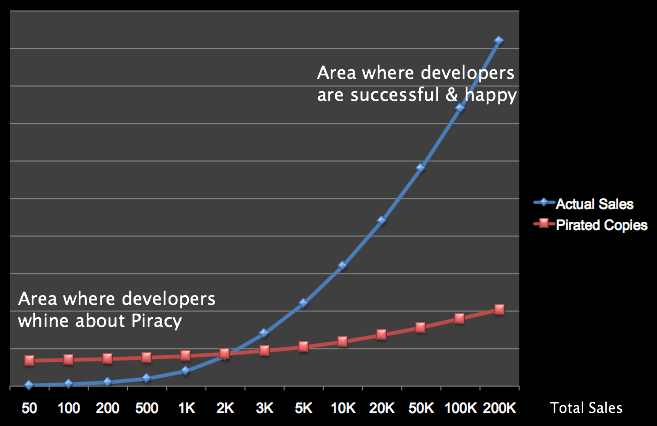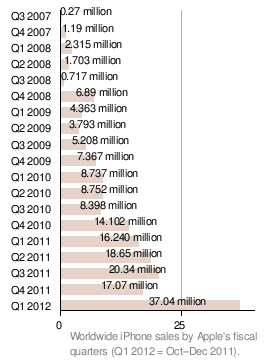It isn’t piracy! … Not even close.
I have a problem with terms that are not clearly defined. Words like “much”, “a lot” or as in this case: “unbelievably high”. If you argue that the problem with Android is its high piracy rate based on one developer’s subjective statement and general hearsay, it’s not an argument.
Before I get to debunk why piracy can’t be that big an issue for Android developers, allow me to restate which developers regularly complain about piracy to begin with. There always seems to be the issue that low selling apps see a much larger percentage of pirated copies being used than high volume apps. This is because some pirates download and try out almost everything that’s available just because they can.
Interestingly, the badly selling app developers seem to be those who complain the most about piracy. Because it’s so easy to blame a failure to sell on piracy. See this fictive graph:
With Apple’s blazing Q1 2012 quarterly results, which sees iPhone sales double (!) that of the previous Q4 2011 and last year’s Q1 quarter, it’s time to update my iOS Device sales statistics from July 2011.
Apple’s Quarterly Results Reports have one big flaw for those interested in per-device numbers: Apple only mentions how many iPhones, iPods and iPads they have sold in each quarter, but this includes all models. So you have to exclude the discontinued models as well as somehow determine (if only by guesstimating) how many iPod touch vs regular iPods, or how many iPhone 3G vs iPhone 3GS have been sold in that quarter.
I took the publicly available numbers and then used a reasonable guesstimate to split the device sales of two combined models in order to get a reasonably accurate estimate. I mainly wanted to determine how the gap is widening between the OpenGL ES 1.1 and OpenGL ES 2.0 models. This is particularly interesting for Cocos2D developers who may be wondering if it’s save to upgrade to Cocos2D 2.x or whether it’s still worthwhile to stick with Cocos2D v1.x to be able to deploy even to 1st and 2nd generation iOS devices. Continue reading »
As summarized by DaringFireball, Apple has loosened their restrictions of section 3.3.1 of its iOS Developer Agreement:
In particular, we are relaxing all restrictions on the development tools used to create iOS apps, as long as the resulting apps do not download any code. This should give developers the flexibility they want, while preserving the security we need.
Previously, the only programming languages allowed to write iOS Apps were C, C++, Objective-C and Javascript. This has now been removed. For cocos2d developers nothing changes, except maybe that you can feel more comfortable embedding a scripting language like Lua into your games. As long as you don’t allow the Lua scripts to be changed by users, or download or otherwise modify/replace bundled Lua scripts. That wasn’t illegal before, however, yet after the change in section 3.3.1 it put a lot of doubt and worry into developers looking into using Lua. So you can now feel much more comfortable using Lua in iOS games, for example by using iPhone Wax.
The removal of these language restrictions is essentially good news for Unity developers (read their statement), and those who wish to develop iOS Apps using a Flash cross-platform compiler and also those using Corona Game Edition, which is entirely Lua-based. And speaking of which, Corona offers developers to purchase Corona SDK and Game Edition at just $99 until only September 15th, after which you’ll have to pay for each product seperately and the price goes up to $249. Just in case you were eye-ing it.
I stumbled across this AppBoy Blog Post about Android and its Market. And it reminded me of what i think when i hear people swearing by the Android: the Android is not going to rule the world. Period.
The reasons are not many but they are crucial. First, Open Source is not a Feature! I hear that very often. “Yeah but Android is Open Source, you can’t compete with that!”. Uh-huh. As a matter of fact, i do not want to compete with Open Source if that means low-quality crap. There is no quality control on the Android Market. For some this spells freedom of choice and what not. And yes, Apple has made some decisions to pull apps from the App Store that a lot of people didn’t like. But let’s not forget that 99% of iPhone OS users just don’t care. There’s still enough diversity, and it’s not like Apple has pulled the Facebook App, Twitterific, Doodle Jump or Angry Birds. Apps that people really use and like. Keep in mind that whenever Apple decides to pull an App, recently that was because of mature content while allowing a big player in that market to keep his Apps online, people talk about that because (a) they like to get upset and (b) the blogosphere and news outlets need something to talk about. In the end it’s just hot air.
Let’s get back to Android though. So it’s open source. What does that even mean? The OS itself is open source. Great for the companies who build their own devices on that software. Bad for the consumer: you still have the same problem all mobile phones have. It’s like switching from Nokia and it’s hundreds of different devices united by the Ovi Store to Android, with its hundred and more and more diverging devices and a united App Store. Where does that lead us? A huge pile of free choice no one really wants if you so will. For developers it gets increasingly harder to develop Apps that run on all Android devices and what’s more, even if you manage to support 99% of all devices right now, tomorrow there will be a new device coming out that won’t run your app. As an independent developer this is hell. You have no way of telling whether supporting a specific line of Android devices will get you a significant sales boost. So how do you calculate how much time you’ll spend on each? It’s pure guesswork. I pity Android developers.
The iPhone market itself is hard but there’s one thing you can and should put all your efforts in: Marketing. You develop for one device (well, ok make that 3) while in the meantime you figure out which websites to target, what to blog, which communities to join, where to apply for App reviews, what Press Releases to send out, etc. The code is already done, Marketing your App is the hard part. It’s the same with the Android, except that the code part with its diverging devices is just as hard to do. And it’s just not fun adapting the same app to different devices. It’s one of the things i wouldn’t mind not doing.
Most of the outspoken people who choose Android choose it because they don’t like Apple (fair enough), or they don’t like closed ecosystems and enjoy (really?) everything that has the label “Open Source” attached to it. However, they’re a minority on the Android market. Most Android users just got what they needed: a working mobile phone. They have no idea, and no clue and don’t care about Open Source. For them, the label “Open Source” has no meaning.













